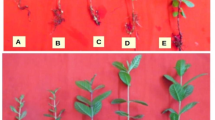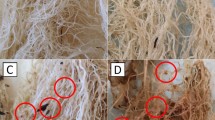Abstract
Four Acacia species were tested for their susceptibility to the root-knot nematode, Meloidogyne javanica, commonly found in sahelian areas. Faidherbia albida and Acacia senegal were resistant to this nematode. On the contrary, A. raddiana, A. nilotica and A. mangium were susceptible. Among these three species, the growth of A. nilotica and A. mangium was inhibited by M. javanica but A. raddiana was tolerant. The rhizobial symbiosis with F. albida and A. senegal was stimulated by the nematode. The population build-up of the root-knot nematode induced by tree species in agroforestry systems is discussed.
Similar content being viewed by others
References
de Guiran G and Netscher C (1970) Les nématodes du genre Meloidogyne parasites de cultures maraîchères au Sénégal. Cah ORSTOM, Ser Biol 11: 151-158
Davide RG and Triantaphyllou AC (1967a) Influence of the environment on development and sex differenciation of root-knot nematodes. I. Effect of infection density, age of the host plant and soil temperature. Nematologica 13: 102-110
Davide RG and Triantaphyllou AC (1967b) Influence of the environment on development and sex differentiation of root-knot nematodes. II. Effect of host nutrition. Nematologica 13: 111-117
Duponnois R and Cadet P (1994) Interactions of Meloidogyne javanica and Glomus sp. on growth and N2 fixation of Acacia seyal. Afro-Asian J Nematol 4: 228-233
Duponnois R, Senghor K and Mateille T (1995) Pathogenicity of Meloidogyne javanica (Treub) Chitw. to Acacia holosericea (A. Cunn ex G. Don) and A. seyal (Del). Nematologica 41: 480-486
Duponnois R, Cadet P, Senghor K and Sougoufara B (1997a) Sensibilité de plusieurs acacias australiens au nématode à galles Meloidogyne javanica. Ann For Sci 54: 179-188
Duponnois R, Tabula TK and Cadet P (1997b) Etude des interactions entre trois espèces d'Acacia (Faidherbia albida Del., A. seyal Del., A. holosericea A Cunn. ex G. Don) et Meloidogyne mayaguensis au Sénégal. Can J Soil Sci 77: 359-365
Johnson AW and Fassuliotis G (1984) Nematode parasites of vegetable crops. In: Nickle WR (ed), Plant and Insect Nematodes, pp 323-372
Munns DN and Mosse B (1980) Mineral nutrition of legume crops. In: Summerfield RJ and Bunting AH (eds) Advances in Legume Sciences, pp 115-125
Seinhorst JW (1950) De betekenis van de toestand von de grond voor het optreden van aanstasting door het stengelaaltje (Ditylenchus dipsaci (Kühn) Filipjev). Tijdschrift over Plantenziekten 56: 292-349
Seinhorst JW (1962) Modifications of the elutriation method for extracting nematodes from soil. Nematologica 8: 117-128
Taylor AL and Sasser JN (1978) Biology, identification and control of Root-knot nematodes. Eds: North Carolina State University Graphics, 111 pp
Thioulouse J, Chessel D, Dolèdec S and Olivier JM (1997) ADE-4: a multivariate analysis and graphical display software. Statistics and Computing 7: 75-83
Author information
Authors and Affiliations
Corresponding author
Rights and permissions
About this article
Cite this article
Ruponnois, R., Senghor, K., Thioulouse, J. et al. Susceptibility of several sahelian Acacia to Meloidogyne javanica (Treub) Chitw.. Agroforestry Systems 46, 123–130 (1999). https://doi.org/10.1023/A:1006213117130
Issue Date:
DOI: https://doi.org/10.1023/A:1006213117130




